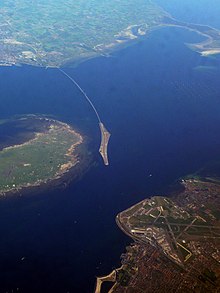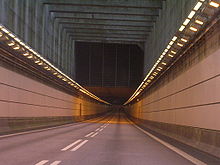Øresund Bridge
Oresund Bridge Øresundsbroen, Öresundsbron | |
|---|---|
| File:Oresundsbroen HCS.jpg | |
| Coordinates | 55°34′31″N 12°49′37″E / 55.57528°N 12.82694°E |
| Carries | 4 lanes of European route E20 Double track Oresund Railway Line |
| Crosses | Oresund strait (The Sound) |
| Locale | Copenhagen, Denmark and Malmö, Sweden |
| Characteristics | |
| Design | Cable-stayed bridge |
| Total length | 7,845 metres (25,738 ft) |
| Width | 23.5 metres (77.1 ft) |
| Longest span | 490 metres (1,608 ft) |
| Clearance below | 57 metres (187 ft) |
| History | |
| Designer | Georg Rotne |
| Opened | July 2, 2000 |
| Statistics | |
| Daily traffic | ca. 17,000 road vehicles |
| Toll | 275DKK[1] /395SEK[2] /38EUR[3] |
| Location | |
 | |
The Øresund or Öresund Bridge (Template:Lang-da, Template:Lang-sv, joint hybrid name: Øresundsbron) is a combined two-track rail and four-lane road bridge-tunnel across the Öresund strait. It is the longest combined road and rail bridge in Europe and connects the two metropolitan areas of the Öresund Region: the Danish capital of Copenhagen and the Swedish city of Malmö. The international European route E20 runs across the bridge and through the tunnel via the two lane motorway, as does the Öresund Railway Line. The construction of the Great Belt Fixed Link and the Øresund have connected mainland Europe to Sweden and the rest of Scandinavia. The bridge was designed by the Danish architectural practice Dissing+Weitling.
The reason for incurring the additional cost and complexity of building a tunnel instead of another section of bridge is to avoid obstructing aircraft from nearby Copenhagen Airport and to provide a clear path for shipping. The bridge crosses the border between Denmark and Sweden, but thanks to the Schengen Agreement and the Nordic Passport Union there are no passport controls. There are frequent customs checks at the toll booths for those entering Sweden but not for those entering Denmark.
Name
In Sweden and Denmark the bridge is most often referred to as Öresundsbron and Øresundsbroen, respectively. The bridge company itself insists on Øresundsbron, a compromise between the two languages. This symbolises a common cultural identity for the region, the people becoming "Öresund citizens" once the bridge is established. Since the crossing actually comprises a bridge, an island, and a tunnel, it is sometimes called, more accurately, the "Öresund Link" or "Öresund Connection" (Danish: Øresundsforbindelsen, Swedish: Öresundsförbindelsen). The Sound Bridge is occasionally heard, using the traditional English name for the strait.
History
Construction of the crossing began in 1995. It was finished on 14 August 1999. Crown Prince Frederik of Denmark and Crown Princess Victoria of Sweden met midway on the bridge to celebrate the completion. The official inauguration took place on 1 July 2000, with Queen Margrethe II, and King Carl XVI Gustaf as guests of honour. The crossing was opened for public traffic later that day. On 12 June 2000, before the inauguration, 79,871 runners competed in a half marathon (Broloppet, the Bridge Run) from Amager (Denmark) to Skåne (Sweden). In spite of two setbacks - the discovery of 16 unexploded World War II bombs on the sea bed and a skewed tunnel segment - the crossing was finished 3 months ahead of schedule.
Initially, the crossing was not used as much as expected, probably because of the high cost. Since 2005, there has been a rapid increase in traffic. This may have been caused by Danes buying homes in Sweden to take advantage of lower house prices in Malmö and commuting to work in Denmark. In 2008, to cross by car cost DKK 260, SEK 325 and € 36.30, although discounts up to 75% are available for regular users. In 2007, almost 25 million people travelled over the bridge: 15.2 million by car and bus, and 9.6 million by train.
Bridge features

At 7,845 m (25,738 ft), the bridge covers half the distance between Sweden and the Danish island of Amager, the border between the two countries being 5.3 km (3.3 mi) from the Swedish end. The structure has a mass of 82,000 tonnes and supports two railway tracks beneath four road lanes in a horizontal girder extending along the entire length of the bridge. On both approaches to the 3 cable-stayed sections, the girder is supported every 140 m (459 ft) by concrete piers. The 2 pairs of free-standing cable supporting towers are 204 m (669 ft) high allowing shipping 57 m (187 ft) of head room under the main span. Even so, most vessels prefer to pass through the unobstructed Drogden Strait above the Drogden Tunnel. The 490 m (1,608 ft) cable-stayed main span is the longest of the type in the world. A girder and cable-stayed design was chosen to provide the rigidity necessary to carry heavy railway traffic. The architect is George Rothne, and the structural design is by Arup.
Peberholm
The bridge joins the Drogden tunnel on the artificial island christened Peberholm (Pepper Islet). With characteristic good humour, the Danes chose the name to complement the natural island of Saltholm (salt islet) just to the north. They also made Peberholm a designated nature reserve. Built from Swedish rock and the soil dredged up during the bridge and tunnel construction, Peberholm is approximately 4 km (2.5 mi) long, with an average width of 500 m (1,640 ft).
Drogden Tunnel

The connection between the artificial island of Peberholm and the artificial peninsula at Kastrup on Amager island - the nearest populated part of Denmark - is through the Drogden Tunnel (Drogdentunnelen). The 4,050 m (13,287 ft) long tunnel comprises a 3,510 m (11,516 ft) undersea tube tunnel plus 270 m (886 ft) entry tunnels at each end. The tube tunnel is made from 20 prefabricated reinforced concrete segments - the most massive in the world at 55,000 tonnes each - interconnected in a trench dug in the seabed. Two tubes in the tunnel carry railway tracks; two more carry roads while a small fifth tube is provided for emergencies. The tubes are arranged side by side.
Rail transport


The public transport by rail product is operated jointly by the Swedish SJ and Danish via DSBFirst on a commission by Skånetrafiken and other county traffic companies (that also sells tickets) and the Danish transport agency. A series of new dual-voltage trains were developed which link the Copenhagen area with Malmö and southern Sweden as far as Gothenburg and Kalmar on selected departures. SJ operate the X2000 and InterCity trains over the bridge with connections to Gothenburg and Stockholm. DSB operates trains to Ystad that connects directly to a ferry to Bornholm. Copenhagen Airport at Kastrup is served by its own train station close to the western bridgehead. Trains operate every 20 minutes over the crossing and once an hour during the night in both directions. An additional couple of Øresundstrains are operated at rush hour and 1-2 per hour and direction SJ trains and DSB trains every other hour. Freight trains also use the crossing.
The rail connection has become popular and is now experiencing congestion. The congestion is mainly on land and not really on the bridge. The railway stations on both sides of the bridge, especially the Malmö Central Station, are the main sources of congestion. People have to stand onboard in rush hour since it is hard to run more trains. The Malmö City Tunnel and its stations will relieve the congestion on the Swedish side.
The rail section is double track standard gauge (1435 mm) and capable of high-speeds up to 200 km/h, but lower in Denmark, especially in the tunnel section. There were challenges related to the difference in electrification and signalling between the Danish and Swedish railway networks. The solution chosen is to switch the electrical system, from Swedish 15 kV, 16.7 Hz to Danish 25 kV, 50 Hz AC right before the eastern bridgehead at Lernacken in Sweden. The line is signalled according to the standard Swedish system across the length of the bridge. On Peberholm, the line switches to Danish signalling which continues into the tunnel. Sweden runs railways with left-hand traffic and Denmark with right-hand traffic. The switch is made at the Malmö Central Station, which is also a terminus. For the new Malmö City Tunnel connection a flyover will pass one track over to the other side.
Costs


The cost for the entire Øresund connection construction, including motorway and railway connections on land, was calculated at DKK 30.1 billion according to the 2000 year price index, with the cost of the bridge paid back by 2035. In 2006 Sweden began spending a further SEK 9.45 billion on the Malmö City Tunnel as a new rail connection to the bridge; it is due for completion in 2010.
The connection will be entirely user financed. The owner company is owned half by the Danish government and half by the Swedish government. This owner company has taken loans guaranteed by the governments to finance the connection, and the user fees are the only incomes for the company. After the increase in traffic these fees are enough to pay the interest and begin paying back the loans, which is expected to take about 30 years.
The tax payers have not paid for the bridge and the tunnel. However, tax money has been used for the land connections. Especially on the Danish side the land connection has domestic benefit, mainly connecting the airport to the railway network. The Malmö City Tunnel has the benefit of connecting the southern part of the inner city to the rail network and allowing many more trains to and from Malmö.
Toll charge
In April 2009, the toll for driving the fixed link was as follows (one way trip without discount) in Danish kroner (DKK), Swedish kronor (SEK) and euro (EUR):
| Vehicle | DKK[1] | SEK[2] | EUR[3] |
|---|---|---|---|
| Motorcycle | 150 | 215 | 21 |
| Standard car | 275 | 380 | 39 |
| Motorhome/car+caravan | 550 | 790 | 75 |
| Minibus (6-9 metres) | 550 | 790 | 75 |
| Bus (longer than 9 metres) | 1145 | 1675 | 157 |
| Lorry/truck (9-20 metres) | 795 | 1170 | 109 |
| Lorry/truck (over 20 metres) | 1190 | 1755 | 163 |
| Train ticket[4] | 78 | 98 | 9 |
There has been criticism of the tolls which are much higher than many consider reasonable for a bridge. However they are comparable with the ferry charges that were levied before the bridge was built and for the ferries still running between Helsingborg-Helsingør.
See also
References
- Notes
- ^ a b [1] - kontantpriser Template:Da icon
- ^ a b [2] - kontantpriser Template:Sv icon
- ^ a b [3] - cash prices Template:En icon
- ^ "Startsida - Öresundståg". Oresundstag.se. Retrieved 2009-05-06.
External links
- Official website
- Øresund Bridge at Structurae
- Øresund Tunnel at Structurae
- Live traffic flow on the bridge (java).
- Øresund bridge project information from Road Traffic Technology
- Impossible Bridges: The Øresund Bridge (National Geographic television channel documentary, 2006)
- Bridges in Denmark
- Bridges in Sweden
- International bridges
- Road-rail bridges
- Cable-stayed bridges
- Bridge-tunnels
- Bridges completed in 2000
- Transport in Copenhagen
- Buildings and structures in Copenhagen
- Malmö
- Scania
- Toll bridges
- Toll tunnels
- Viaducts
- Connections across the Baltic Sea
- Undersea tunnels
- Denmark–Sweden border crossings
